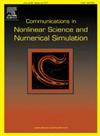Dynamics of multiple higher-order pole solutions of a two-component Sasa-Satsuma equation based on Riemann–Hilbert approach and PINN algorithm
IF 3.8
2区 数学
Q1 MATHEMATICS, APPLIED
Communications in Nonlinear Science and Numerical Simulation
Pub Date : 2025-09-22
DOI:10.1016/j.cnsns.2025.109346
引用次数: 0
Abstract
Using the inverse scattering transform, we systematically present a Riemann–Hilbert (RH) approach to the Cauchy problem for a two-component Sasa–Satsuma equation with zero boundary conditions as . The direct scattering problem establishes the analyticity, symmetries of the Jost solutions and scattering matrix, and particularly, a detailed analysis of the discrete spectrum in the presence of multiple higher-order zeros of the determinant of analytic scattering coefficient. The inverse scattering problem is addressed through a corresponding matrix-valued RH problem associated with the residual conditions of these higher-order poles. The reconstruction formula for the solution is derived. Then, under reflectionless conditions, we settle the RH problem which can be transformed into a linear algebraic system, and obtain the formula of multiple higher-order pole solutions to the two-component Sasa–Satsuma equation. Subsequently, we employed the data obtained through the RH method to train the physics-informed neural network (PINN) and an improved version of PINN, enabling us to derive various types of data-driven solutions for the two-component Sasa–Satsuma equation. The results demonstrate that the algorithm shows outstanding training performance for both one-soliton and two-soliton solutions, as well as for more complex second-order and third-order pole solutions. Finally, we explore the data-driven parameters discovery problem in the context of one-soliton solution using the PINN algorithm. These findings highlight the robustness of the PINN framework in handling complex nonlinear equations and its potential for applications in various fields, including fluid dynamics and optical communications.
基于Riemann-Hilbert方法和PINN算法的双分量Sasa-Satsuma方程多高阶极点解动力学
利用逆散射变换,系统地给出了零边界条件下双分量Sasa-Satsuma方程为|x|→∞的Cauchy问题的Riemann-Hilbert方法。直接散射问题建立了Jost解和散射矩阵的解析性、对称性,特别是详细分析了解析散射系数行列式存在多个高阶零时的离散谱。逆散射问题是通过与这些高阶极点的残余条件相关的相应4×4矩阵值RH问题来解决的。导出了解的重构公式。然后,在无反射条件下,求解了可转化为线性代数系统的RH问题,得到了双分量Sasa-Satsuma方程的多个高阶极点解的表达式。随后,我们使用通过RH方法获得的数据来训练物理信息神经网络(PINN)和改进版本的PINN,使我们能够推导出双组分Sasa-Satsuma方程的各种类型的数据驱动解决方案。结果表明,该算法对单孤子和双孤子解以及更复杂的二阶和三阶极点解都有很好的训练效果。最后,我们利用PINN算法探讨了单孤子解的数据驱动参数发现问题。这些发现突出了PINN框架在处理复杂非线性方程方面的鲁棒性及其在包括流体动力学和光通信在内的各个领域的应用潜力。
本文章由计算机程序翻译,如有差异,请以英文原文为准。
求助全文
约1分钟内获得全文
求助全文
来源期刊

Communications in Nonlinear Science and Numerical Simulation
MATHEMATICS, APPLIED-MATHEMATICS, INTERDISCIPLINARY APPLICATIONS
CiteScore
6.80
自引率
7.70%
发文量
378
审稿时长
78 days
期刊介绍:
The journal publishes original research findings on experimental observation, mathematical modeling, theoretical analysis and numerical simulation, for more accurate description, better prediction or novel application, of nonlinear phenomena in science and engineering. It offers a venue for researchers to make rapid exchange of ideas and techniques in nonlinear science and complexity.
The submission of manuscripts with cross-disciplinary approaches in nonlinear science and complexity is particularly encouraged.
Topics of interest:
Nonlinear differential or delay equations, Lie group analysis and asymptotic methods, Discontinuous systems, Fractals, Fractional calculus and dynamics, Nonlinear effects in quantum mechanics, Nonlinear stochastic processes, Experimental nonlinear science, Time-series and signal analysis, Computational methods and simulations in nonlinear science and engineering, Control of dynamical systems, Synchronization, Lyapunov analysis, High-dimensional chaos and turbulence, Chaos in Hamiltonian systems, Integrable systems and solitons, Collective behavior in many-body systems, Biological physics and networks, Nonlinear mechanical systems, Complex systems and complexity.
No length limitation for contributions is set, but only concisely written manuscripts are published. Brief papers are published on the basis of Rapid Communications. Discussions of previously published papers are welcome.
 求助内容:
求助内容: 应助结果提醒方式:
应助结果提醒方式:


